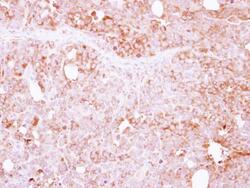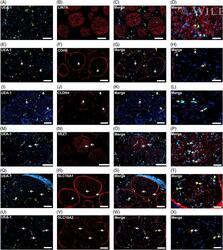Antibody data
- Antibody Data
- Antigen structure
- References [3]
- Comments [0]
- Validations
- Immunocytochemistry [3]
- Immunohistochemistry [1]
- Other assay [1]
Submit
Validation data
Reference
Comment
Report error
- Product number
- PA5-30871 - Provider product page

- Provider
- Invitrogen Antibodies
- Product name
- LIN7A Polyclonal Antibody
- Antibody type
- Polyclonal
- Antigen
- Recombinant full-length protein
- Description
- Recommended positive controls: NT2D1, IMR32, U87-MG, MCF-7. Predicted reactivity: Mouse (100%), Rat (100%), Zebrafish (97%), Bovine (100%). Store product as a concentrated solution. Centrifuge briefly prior to opening the vial.
- Reactivity
- Human, Mouse
- Host
- Rabbit
- Isotype
- IgG
- Vial size
- 100 μL
- Concentration
- 1 mg/mL
- Storage
- Store at 4°C short term. For long term storage, store at -20°C, avoiding freeze/thaw cycles.
Submitted references The loss of DLG2 isoform 7/8, but not isoform 2, is critical in advanced staged neuroblastoma.
In situ molecular characterization of endoneurial microvessels that form the blood-nerve barrier in normal human adult peripheral nerves.
Heterodimerization with the β(1) subunit directs the α(2) subunit of nitric oxide-sensitive guanylyl cyclase to calcium-insensitive cell-cell contacts in HEK293 cells: Interaction with Lin7a.
Keane S, Martinsson T, Kogner P, Ejeskär K
Cancer cell international 2021 Mar 16;21(1):170
Cancer cell international 2021 Mar 16;21(1):170
In situ molecular characterization of endoneurial microvessels that form the blood-nerve barrier in normal human adult peripheral nerves.
Ouyang X, Dong C, Ubogu EE
Journal of the peripheral nervous system : JPNS 2019 Jun;24(2):195-206
Journal of the peripheral nervous system : JPNS 2019 Jun;24(2):195-206
Heterodimerization with the β(1) subunit directs the α(2) subunit of nitric oxide-sensitive guanylyl cyclase to calcium-insensitive cell-cell contacts in HEK293 cells: Interaction with Lin7a.
Hochheiser J, Haase T, Busker M, Sömmer A, Kreienkamp HJ, Behrends S
Biochemical pharmacology 2016 Dec 15;122:23-32
Biochemical pharmacology 2016 Dec 15;122:23-32
No comments: Submit comment
Supportive validation
- Submitted by
- Invitrogen Antibodies (provider)
- Main image

- Experimental details
- LIN7A Polyclonal Antibody detects LIN7A protein at cell membrane by immunofluorescent analysis. Sample: MCF-7 cells were fixed in ice-cold MeOH for 5 min. Green: LIN7A protein stained by LIN7A Polyclonal Antibody (Product # PA5-30871) diluted at 1:1,000. Blue: Hoechst 33342 staining. Scale bar = 10 µm.
- Submitted by
- Invitrogen Antibodies (provider)
- Main image

- Experimental details
- LIN7A Polyclonal Antibody detects LIN7A protein at cell membrane by immunofluorescent analysis. Sample: MCF-7 cells were fixed in ice-cold MeOH for 5 min. Green: LIN7A protein stained by LIN7A Polyclonal Antibody (Product # PA5-30871) diluted at 1:1,000. Blue: Hoechst 33342 staining. Scale bar = 10 µm.
- Submitted by
- Invitrogen Antibodies (provider)
- Main image

- Experimental details
- LIN7A Polyclonal Antibody detects LIN7A protein at cell membrane by immunofluorescent analysis. Sample: MCF-7 cells were fixed in ice-cold MeOH for 5 min. Green: LIN7A protein stained by LIN7A Polyclonal Antibody (Product # PA5-30871) diluted at 1:1,000. Blue: Hoechst 33342 staining. Scale bar = 10 µm.
Supportive validation
- Submitted by
- Invitrogen Antibodies (provider)
- Main image

- Experimental details
- Immunohistochemical analysis of paraffin-embedded human colon carcinoma, using LIN7A (Product # PA5-30871) antibody at 1:250 dilution. Antigen Retrieval: Citrate buffer, pH 6.0, 15 min.
Supportive validation
- Submitted by
- Invitrogen Antibodies (provider)
- Main image

- Experimental details
- Restrictive junctional complex and transporter proteins. Representative indirect fluorescent digital photomicrographs of cryostat axial sections of normal adult sural nerves show UEA-1-positive endothelial cells (green; A, E, I, M, Q, U) with expression of LIN7A, CDH5, CLDN4, VEZT, SLC16A1 and SLC19A2 (red; B, F, J, N, R, V, respectively) restricted to endoneurial microvessels shown in the merged images at lower and higher magnifications (yellow/ orange). LIN7A expression by endoneurial microvessels is apparent only at higher magnification (D). These proteins are expressed by the restrictive blood-nerve barrier and shared with other selected cell types suggesting specialized roles in the restrictive junctional complex formation (LIN7A, CDH5, CLDN4 and VEZT) or specialized nutrient transporters (SLC16A1 and SLC19A2) within normal adult peripheral nerves, as determined by known morphological profiles in situ. White arrows demonstrate positively staining endoneurial microvascular endothelium. Blue (4, 6-diamidino-2-phenylindole) staining indicates nuclei. Scale bar 500 mum for A-C, E-G, I-K, M-O, Q-S and U-W, and 125 mum for D, H, L, P, T and X
 Explore
Explore Validate
Validate Learn
Learn Western blot
Western blot Immunocytochemistry
Immunocytochemistry